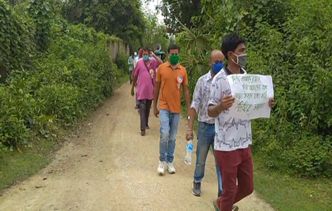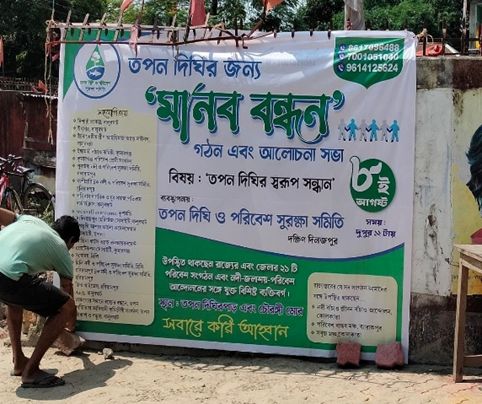Tapas Das, a river and water body conservationist based out of Kolkata, is leading the fight to save several local natural water bodies. “While I was actively involved in student politics during my college days, I grew concerned with several developments around me that adversely impacted water bodies. That was when I got inspired to work on river conservation,” he recalls.
Growing up in a joint family, Das’s journey began in 2007 when he travelled along the coastline of India barefoot, starting from Gangasagar in West Bengal to Gujarat, covering multiple states. Although people’s language, food, and culture changed every 100 kilometres, the problems with water access and availability seemed universal. He decided to take a hard look at the larger issue of India’s water crisis and join efforts on water body conservation.
A water-rich country with plentiful rains and hundreds of rivers crisscrossing the hinterland has to struggle with water at various places. “We face floods during monsoon and droughts in summers. The problem lies in poor planning, as we create infrastructure mindlessly without due thought to ecology. The relationship that India always had with the rivers and nature has to be protected, and my work revolves around keeping rivers at the centre,” says Das.
Das started his movement based on rivers - ‘Nadi Bachao, Jiban Bachao Andolan’ (Save River, Save Life Movement). In 2014, he came into prominence when he organized a cycle rally covering 2200 km from Gomukh to Gangasagar to protest against the construction of barrages at every 100 kilometres stretch on the Ganges. Like most other environmentalists, he also believed that this would cut the chord of Ganges into several pieces and turn it into smaller lakes by blocking the natural course.
India has more than 5000 large dams currently, which in many cases has destroyed the natural flow of rivers and caused unnatural river drought and flood-like conditions and arsenic pollution problems as sediment deposits behind the dam contain heavy metals such as arsenic.
Das led several conventions and brought together large masses to fight for the cause. In 2017, in the Mourigram Convention, his team charted a clear roadmap to tackle this issue and continued their fight to raise awareness across different stakeholders, including the government.
Das is also concerned about Bengal, his home state. The state’s agricultural growth rate has been higher than the national average. This could be due to the presence of several rivers and their tributaries. However, many places in Bengal are facing water crisis and arsenic pollution in the last decade. The state has constructed multiple dams and changed the natural flow of rivers by creating canals and channels.
The booming real estate in urban areas has led to shrinking space for nature. The last 5-10 years has seen the indiscriminate filling of ponds and lakes by urban local bodies to create roads and houses. Recently, this reached Das’s neighbourhood at Behala (Kolkata), where the state government is filling some portions of the 22 km long Charial Khal (Charial Canal) for making roads. Charial is one of the oldest canals and has historical mentions dating back to the rule of Jahangir (Mughal Emperor) and the British. It was renovated multiple times earlier and in a major overhaul, it was extended by 3 kms in the 1980s.
This canal is popular locally and helps recharge groundwater apart from keeping the area cool. Das laments the government’s short-term approach unmindful of the adverse side effects of rampant infrastructure development. “India is a signatory to several treaties and conventions opposed to such activities, yet the Kolkata Municipal Corporation continues to undertake works that undermine these. This reflects the age-old colonial mindset of infrastructure building with no heed to the harm it causes to nature,” says Das.
He believes that such activities call for greater struggle by the activists. Starting from organizing conventions, writing letters to the administration, and protesting, Das is amplifying the voices against the indiscriminate filling and encroachment of water bodies.
The work of Das has not only been limited to the urban centres but has also reached far fetched rural areas like Tapan, a village in the northern district of Dakshin Dinajpur, West Bengal. The village is named after a huge local water body - ‘Tapan Dighi’ (Dighi means lake in Bengali). The local administration is currently building a wall around the lake to ‘protect’ it.
Das finds this logic absurd as it only creates a barrier between nature and humans. The erection of the wall will deprive the local community of its aesthetic view, apart from its use for various purposes and restrict the ecosystem services the community derives out of it. Tapas Das has been at the forefront of the movement and is raising awareness by bringing together the local community. From organizing street protests to building a human chain, his team is leaving no stone unturned to increase awareness and in bringing down the long wall.


Protest march to save Tapan Dighi (Image: Tapan Dighi Bachao Facebook Page)
Being a follower of Rabindranath Tagore and Gandhiji, Tapas Das believes we are moving away from nature by coming up with such projects. These projects are eating up the government’s finances and opening up a never-ending loop of investments required to protect them and secure the new group affected by the development. We have walked a long way with faulty development projects and now need to develop infrastructure to protect the environment.
Tapas Das believes that he will be able to channel people’s sentiment against such activities and hopes that the new generation will join his cause to steer the movement for conserving water bodies forward.
Author: Subhrajyoti Karmakar is a student at IIM Bangalore













